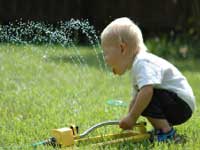|
 Unfortunately, excessive watering of a lawn is not
good for the grass; in addition, the lawn makes a
nice filter for things absorbed that could be washed
into the rivers and streams. The best lawn is one
that could be grown without much additional watering
then what the environment provides. In other words,
whatever water nature provides should be enough for
the lawn without the homeowner standing outside
every night with a garden hose watering down the
lawn, they probably have better things to do and it
wastes money.
Unfortunately, excessive watering of a lawn is not
good for the grass; in addition, the lawn makes a
nice filter for things absorbed that could be washed
into the rivers and streams. The best lawn is one
that could be grown without much additional watering
then what the environment provides. In other words,
whatever water nature provides should be enough for
the lawn without the homeowner standing outside
every night with a garden hose watering down the
lawn, they probably have better things to do and it
wastes money.
In order to maintain a lush emerald colored grass and
active growth, turf grass should be watered
approximately ¾ inch to one inch each week only.
There are, however, several times during the summer
months in which high temperatures are typical and a
homeowner could allow the grass to slow down its
natural growing process during these times. A lawn
could go dormant in which it barely grows during
extreme conditions.
Before the summer
months are upon us, decide if the lawn is going to
be watered on a regular basis or allowed to go
dormant for the season. It is dangerous to allow the
grass to go brown and then water it enough for it to
turn green again and then repeat the cycle. Grass is
a plant and doing this starving and then feeding the
grass could deplete huge amounts of reserved food
the grass has stored.
In order to increase
root growth, allow a lawn to begin to show signs of
stress from drought conditions. As grass goes under
drought stress it will begin to turn darker and
footprints left in the lawn will remain in the lawn
instead of disappearing as in a healthy, well fed
lawn. Another choice to check for drought stress
would be to look at the root soil for any signs of
dryness and weakness.
So that water soaks
down to the roots, water completely if and when
watering. Newly seeded lawns – where the surface
needs to stay moist all the time; freshly sodded
grass that do not have roots in the soil and if
summer patch disease is a problem are the exceptions
to the watering rule.
The best time to
water a lawn is early in the day. A lawn is
typically wet already from morning dew which helps
with water consumption. If at all possible, try to
steer clear of midday watering because of the
evaporation factor. Night time watering is also bad
for the lawn because it may be easier for a lawn
disease to ‘put down roots’ in the lawn. When the
temperature reaches extreme highs during the day and
the evening temperature is not going to dip below 20
degrees Celsius, go ahead and water in the late
afternoon or evening. Check with your local water
company or city municipality to see if there are any
water restrictions placed on lawn watering before
beginning to water the lawn. By avoiding the high
temperatures which could cause the water to
evaporate, more of the natural clear liquid needed
to grow a lawn reaches the roots.
|



 Unfortunately, excessive watering of a lawn is not
good for the grass; in addition, the lawn makes a
nice filter for things absorbed that could be washed
into the rivers and streams. The best lawn is one
that could be grown without much additional watering
then what the environment provides. In other words,
whatever water nature provides should be enough for
the lawn without the homeowner standing outside
every night with a garden hose watering down the
lawn, they probably have better things to do and it
wastes money.
Unfortunately, excessive watering of a lawn is not
good for the grass; in addition, the lawn makes a
nice filter for things absorbed that could be washed
into the rivers and streams. The best lawn is one
that could be grown without much additional watering
then what the environment provides. In other words,
whatever water nature provides should be enough for
the lawn without the homeowner standing outside
every night with a garden hose watering down the
lawn, they probably have better things to do and it
wastes money.